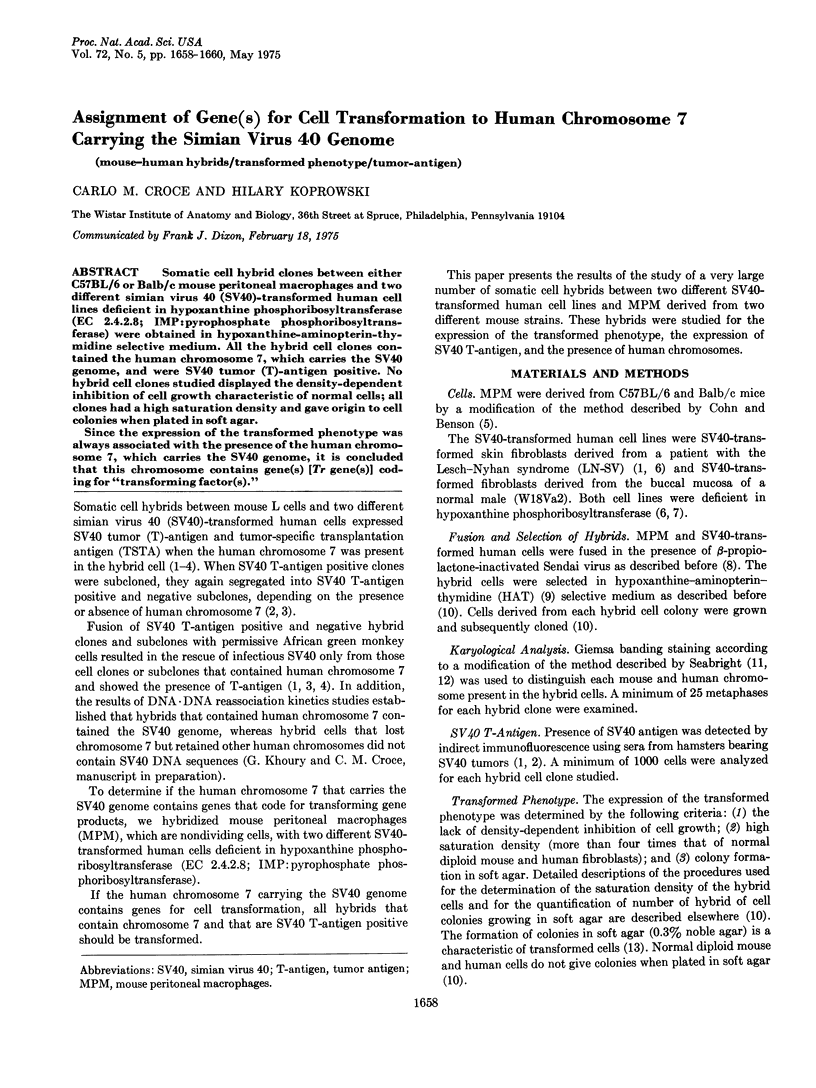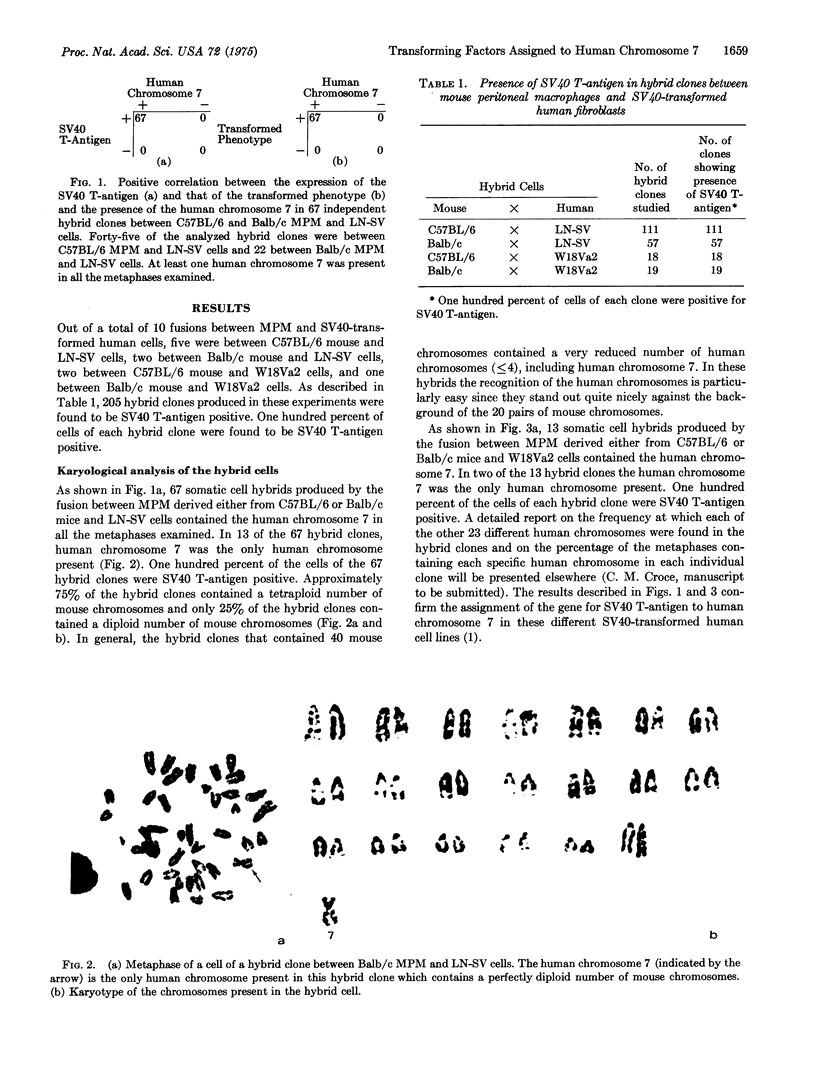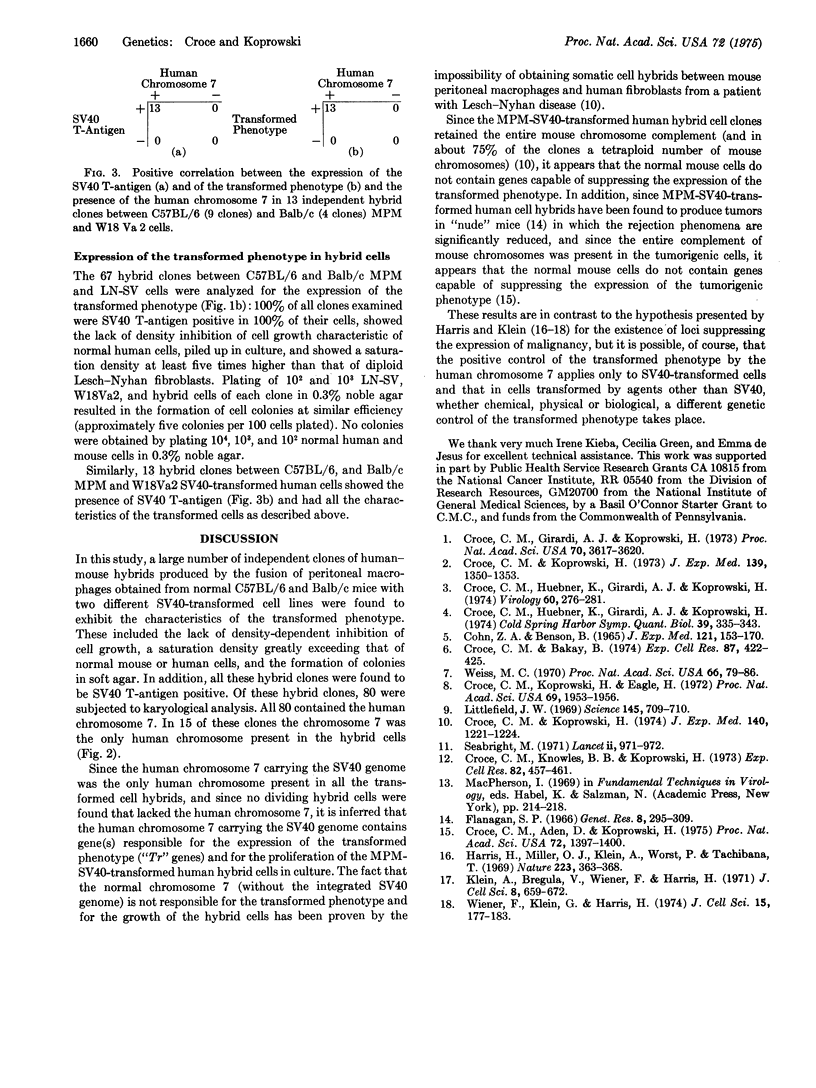Abstract
Somatic cell hybrid clones between either C57BL/6 or Balb/c mouse peritoneal macrophages and two different simian virus 40 (SV40)-transformed human cell lines deficient in hypoxanthine phosphoribosyltransferase (EC 2.4.2.8; IMP:pyrophosphate phosphoribosyltransferase) were obtained in hypoxanthine-aminopterin-thymidine selective medium. All the hybrid cell clones contained the human chromosome 7, which carries the SV40 genome, and were SV40 tumor (T)-antigen positive. No hybrid cell clones studied displayed the density-dependent inhibition of cell growth characteristic of normal cells; all clones had a high saturation density and gave origin to cell colonies when plated in soft agar. Since the expression of the transformed phenotype was always associated with the presence of the human chromosome 7, which carries the SV40 genome, it is concluded that this chromosome contains gene(s) [Tr gene(s)] coding for "transforming factor(s)."
Full text
PDF


Images in this article
Selected References
These references are in PubMed. This may not be the complete list of references from this article.
- COHN Z. A., BENSON B. THE DIFFERENTIATION OF MONONUCLEAR PHAGOCYTES. MORPHOLOGY, CYTOCHEMISTRY, AND BIOCHEMISTRY. J Exp Med. 1965 Jan 1;121:153–170. doi: 10.1084/jem.121.1.153. [DOI] [PMC free article] [PubMed] [Google Scholar]
- Croce C. M., Aden D., Koprowski H. Somatic cell hybrids between mouse peritoneal macrophages and simian-virus-40-transformed human cells: II. Presence of human chromosome 7 carrying simin virus 40 genome in cells of tumors induced by hybrid cells. Proc Natl Acad Sci U S A. 1975 Apr;72(4):1397–1400. doi: 10.1073/pnas.72.4.1397. [DOI] [PMC free article] [PubMed] [Google Scholar]
- Croce C. M., Bakay B. Presence of two active X chromosomes in hybrids between normal human and SV40-transformed fibroblasts from patients with the Lesch-Nyhan syndrome. Exp Cell Res. 1974 Aug;87(2):422–425. doi: 10.1016/0014-4827(74)90509-6. [DOI] [PubMed] [Google Scholar]
- Croce C. M., Girardi A. J., Koprowski H. Assignment of the T-antigen gene of simian virus 40 to human chromosome C-7. Proc Natl Acad Sci U S A. 1973 Dec;70(12):3617–3620. doi: 10.1073/pnas.70.12.3617. [DOI] [PMC free article] [PubMed] [Google Scholar]
- Croce C. M., Huebner K., Girardi A. J., Koprowski H. Genetics of cell transformation by simian virus 40. Cold Spring Harb Symp Quant Biol. 1975;39(Pt 1):335–343. doi: 10.1101/sqb.1974.039.01.044. [DOI] [PubMed] [Google Scholar]
- Croce C. M., Huebner K., Girardi A. J., Koprowski H. Rescue of defective SV40 from mouse-human hybrid cells containing human chromosome 7. Virology. 1974 Jul;60(1):276–281. doi: 10.1016/0042-6822(74)90385-7. [DOI] [PubMed] [Google Scholar]
- Croce C. M., Knowles B. B., Koprowski H. Preferential retention of the human chromosome C-7 in human-(thymidine kinase deficient) mouse hybrid cells. Exp Cell Res. 1973 Dec;82(2):457–461. doi: 10.1016/0014-4827(73)90366-2. [DOI] [PubMed] [Google Scholar]
- Croce C. M., Koprowski H. Concordant segregation of the expression of SV40 T antigen and human chromosome 7 in mouse-human hybrid subclones. J Exp Med. 1974 May 1;139(5):1350–1353. doi: 10.1084/jem.139.5.1350. [DOI] [PMC free article] [PubMed] [Google Scholar]
- Croce C. M., Koprowski H., Eagle H. Effect of environmental pH on the efficiency of cellular hybridization. Proc Natl Acad Sci U S A. 1972 Jul;69(7):1953–1956. doi: 10.1073/pnas.69.7.1953. [DOI] [PMC free article] [PubMed] [Google Scholar]
- Croce C. M., Koprowski H. Somatic cell hybrids between mouse peritoneal macrophages and SV40-transformed human cells. I. Positive control of the transformed phenotype by the human chromosome 7 carrying the SV40 genome. J Exp Med. 1974 Nov 1;140(5):1221–1229. doi: 10.1084/jem.140.5.1221. [DOI] [PMC free article] [PubMed] [Google Scholar]
- Flanagan S. P. 'Nude', a new hairless gene with pleiotropic effects in the mouse. Genet Res. 1966 Dec;8(3):295–309. doi: 10.1017/s0016672300010168. [DOI] [PubMed] [Google Scholar]
- Harris H., Miller O. J., Klein G., Worst P., Tachibana T. Suppression of malignancy by cell fusion. Nature. 1969 Jul 26;223(5204):363–368. doi: 10.1038/223363a0. [DOI] [PubMed] [Google Scholar]
- Klein G., Bregula U., Wiener F., Harris H. The analysis of malignancy by cell fusion. I. Hybrids between tumour cells and L cell derivatives. J Cell Sci. 1971 May;8(3):659–672. doi: 10.1242/jcs.8.3.659. [DOI] [PubMed] [Google Scholar]
- LITTLEFIELD J. W. SELECTION OF HYBRIDS FROM MATINGS OF FIBROBLASTS IN VITRO AND THEIR PRESUMED RECOMBINANTS. Science. 1964 Aug 14;145(3633):709–710. doi: 10.1126/science.145.3633.709. [DOI] [PubMed] [Google Scholar]
- Seabright M. A rapid banding technique for human chromosomes. Lancet. 1971 Oct 30;2(7731):971–972. doi: 10.1016/s0140-6736(71)90287-x. [DOI] [PubMed] [Google Scholar]
- Weiss M. C. Further studies on loss of T-antigen from somatic hybrids between mouse cells and SV40-transformed human cells. Proc Natl Acad Sci U S A. 1970 May;66(1):79–86. doi: 10.1073/pnas.66.1.79. [DOI] [PMC free article] [PubMed] [Google Scholar]
- Wiener F., Klein G., Harris H. The analysis of malignancy by cell fusion. V. Further evidence of the ability of normal diploid cells to suppress malignancy. J Cell Sci. 1974 Jun;15(1):177–183. doi: 10.1242/jcs.15.1.177. [DOI] [PubMed] [Google Scholar]



